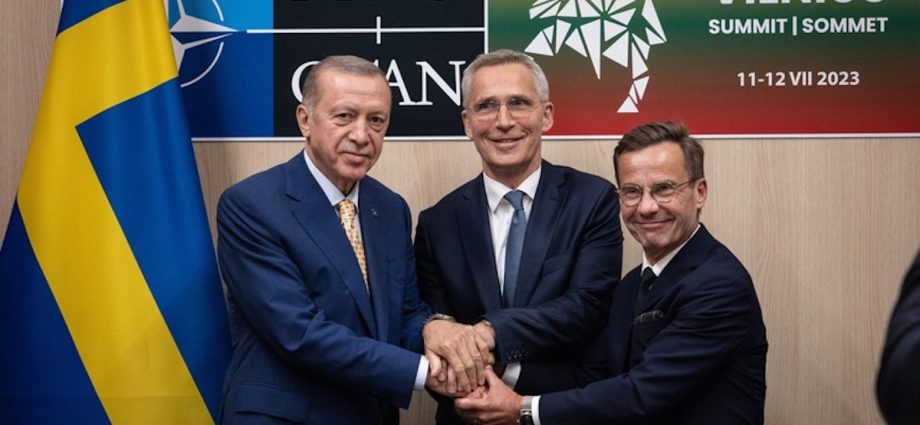
The cracks, long expected, are beginning to show. At the NATO summit in Vilnius, frictions between members and Ukraine boiled over. Ukrainian President Volodomyr Zelensky, angered that the North Atlantic Treaty Organization refused to set a timeline for Kiev to join the alliance, called the situation “absurd.”
That rare public criticism drew an immediate response from the two countries that have offered the most support. First Britain’s defense secretary, Ben Wallace, pointed out that “people want to see a bit of gratitude,” and noted that Ukrainian politicians had a habit of asking for one type of weapon, being given it, and immediately starting to ask for another type.
Speaking later, US national security adviser Jake Sullivan echoed Wallace’s message, saying he felt “the American people do deserve a degree of gratitude.”
Zelensky, clearly chastened and surprised at the response, told reporters later that day that Ukraine was grateful.
A rare spat, then, after more than a year of a bloody and bruising war. The Russian invasion of Ukraine has taken an enormous toll on Ukraine, first and foremost, but also on hundreds of millions of people around the world. For those NATO countries that have provided the most money and weapons, the war has resulted in a considerable cost in inflation and the daily cost of living.
That fracturing of the alliance was long predicted and exactly what Russia was counting on in a prolonged war. But these cracks are not what Moscow predicted. Far from being a sign of a fracturing among NATO allies, the cracks are actually a result of the alliance expanding – and taking on a new, more confrontational shape.
The idea that a prolonged war in Ukraine favors Moscow has been around since the start of the invasion; it must have provided some of the baseline calculation for going in. Western countries, no matter how supportive they were initially, would eventually tire, so the theory went, and find it harder to justify the toll the war was taking to their populations.
Broadly, that has happened. The Ukraine war has exacerbated inflation and a concurrent economic crisis across many parts of the West. (In the Global South, the effect has been much more pronounced.) Polls show that European publics are tiring of the war and its effect on the economy – but not by as much as expected.
The unexpected factor has been the political response and the unifying effect the war had, particularly in NATO, an alliance that had been adrift for years. This summit was the moment the change became real.
For the first time in years, members agreed a new comprehensive plan for its future security. The plans, which run to thousands of pages of classified text, are naturally secret, but reports indicate that they cover deployments, new equipment and investment.
In other words, NATO is finally telling its members how much to spend and what to spend it on – something that countries with bigger militaries, such as France and Turkey, have long chafed at.
This realignment of NATO is real, and irreversible in the medium term. Even as late as last autumn it was probably reversible. Had the war ended then, even in an imperfect truce, it’s possible the inertia that has gripped NATO members for two decades could have reasserted itself.
NATO in for the long haul
But now the alliance is committed, with a new military doctrine that emphasizes preparation for a prolonged, grinding, land and air war, conducted across the entirety of the European continent, as opposed to the bounded wars in Afghanistan and Iraq.
All of that means a new posture on the continent.
The positive side of that posture – from the perspective of the NATO members that will have to carry it out – is that the task is clear.
But the flip side is that NATO members are now starting to think seriously about their future and whether they can defend their countries.
Ukraine is using up vast quantities of weaponry, which, as Wallace pointed out in Vilnius, in essence means Kiev is “persuading countries to give up their own stocks” of weapons.
The most commonly cited example of this is the 155mm howitzer artillery shells that the US gives Ukraine.
Kiev is burning through these at an unsustainable rate – how unsustainable is a military secret, but Ukraine appears to be using more shells in two days, or perhaps 10 days, it hardly matters, as the US can produce in a month. In the long term, that presents a problem, for both Kiev and Washington.
The amount of weaponry given is getting to the point of either/or – either NATO countries have enough for their own defense, or they give Ukraine what it wants. Hence the jitters and irritation that seeped out at the summit.
None of this is good news for Russia, however social media tried to spin the spat. An invasion of Ukraine would have only worked for Russia if it could have been swift – which it turned out not to be – or swiftly forgotten, like the 2014 occupation of Crimea.
It may, however, be good news for Vladimir Putin. An invasion that provoked a complete realignment on the continent would cast Russia into the permanent role of outsider – a role in which Putin is comfortable and which he can sell rather too easily to the Russian public when elections next roll around.
The most consequential NATO summit in decades has seen the alliance take on a new role, one rather too similar to the role it played years ago.
This article was provided by Syndication Bureau, which holds copyright.
Faisal Al Yafai is currently writing a book on the Middle East and is a frequent commentator on international TV news networks. He has worked for news outlets such as The Guardian and the BBC, and reported on the Middle East, Eastern Europe, Asia and Africa. Follow him on Twitter @FaisalAlYafai.

